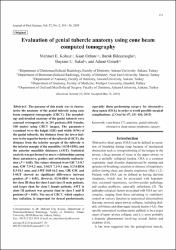| dc.contributor.author | Kolsuz, Mehmet Eray | |
| dc.contributor.author | Orhan, Kaan | |
| dc.contributor.author | Bilecenoğlu, Burak | |
| dc.contributor.author | Şakul, Bayram Ufuk | |
| dc.contributor.author | Öztürk, Adnan | |
| dc.date.accessioned | 10.07.201910:49:13 | |
| dc.date.accessioned | 2019-07-10T19:58:52Z | |
| dc.date.available | 10.07.201910:49:13 | |
| dc.date.available | 2019-07-10T19:58:52Z | |
| dc.date.issued | 2015 | en_US |
| dc.identifier.citation | Kolsuz, M. E., Orhan, K., Bilecenoğlu, B., Şakul, B. U. ve Öztürk, A. (2015). Evaluation of genial tubercle anatomy using cone beam computed tomography. Journal of Oral Science, 57(2), 151-156. https://dx.doi.org/10.2334/josnusd.57.151 | en_US |
| dc.identifier.issn | 1343-4934 | |
| dc.identifier.issn | 1880-4926 | |
| dc.identifier.uri | https://dx.doi.org/10.2334/josnusd.57.151 | |
| dc.identifier.uri | https://hdl.handle.net/20.500.12511/3241 | |
| dc.description | WOS: 000356203400013 | en_US |
| dc.description | PubMed ID: 26062865 | en_US |
| dc.description.abstract | The purpose of this study was to characterize the anatomy of the genial tubercle using cone beam computed tomography (CBCT). The morphology and detailed anatomy of the genial tubercle were assessed retrospectively in 201 patients (101 females, 100 males) using CBCT images. The parameters examined were the height (GH) and width (GW) of the genial tubercle, the distance from the lower incisors to the superior border of the tubercle (I-SGT), the distance from the inferior margin of the tubercle to the inferior margin of the mandible (IGM-IBM), and the anterior mandible thickness (AMT). Statistical analysis was performed to assess relationships among these parameters, gender, and orthodontic malocclusion (P < 0.05). The values obtained were 614 7.3-8.7 mm, GW 7.9-9.2 mm, I-SGT 7.1-9.1 mm, IGM-IBM 8.3-10.1 mm, and AMT 14.0-16.2 mm. GH, GW, and I-SGT showed no significant differences between genders (P > 0.05). However, IGM-IBM was larger for class III than for class I and class II male patients, and larger than for class I female patients. AMT in class III patients was greater than in class I and II patients (P < 0.05). The use of CBCT, which employs less radiation, is important for dental professionals, especially those performing surgery for obstructive sleep apnea (OSA), in order to avoid possible surgical complications. | en_US |
| dc.language.iso | eng | en_US |
| dc.publisher | Nihon University, School of Dentistry | en_US |
| dc.rights | info:eu-repo/semantics/openAccess | en_US |
| dc.subject | Cone-Beam CT | en_US |
| dc.subject | Anatomy | en_US |
| dc.subject | Genial Tubercle | en_US |
| dc.subject | Obstructive Sleep Apnea Syndrome | en_US |
| dc.subject | Surgery | en_US |
| dc.title | Evaluation of genial tubercle anatomy using cone beam computed tomography | en_US |
| dc.type | article | en_US |
| dc.relation.ispartof | Journal of Oral Science | en_US |
| dc.department | İstanbul Medipol Üniversitesi, Tıp Fakültesi, Temel Tıp Bilimleri Bölümü, Anatomi Ana Bilim Dalı | en_US |
| dc.authorid | 0000-0002-5539-2342 | en_US |
| dc.identifier.volume | 57 | en_US |
| dc.identifier.issue | 2 | en_US |
| dc.identifier.startpage | 151 | en_US |
| dc.identifier.endpage | 156 | en_US |
| dc.relation.publicationcategory | Makale - Uluslararası Hakemli Dergi - Kurum Öğretim Elemanı | en_US |
| dc.identifier.doi | 10.2334/josnusd.57.151 | en_US |
| dc.identifier.wosquality | Q4 | en_US |
| dc.identifier.scopusquality | Q3 | en_US |


















